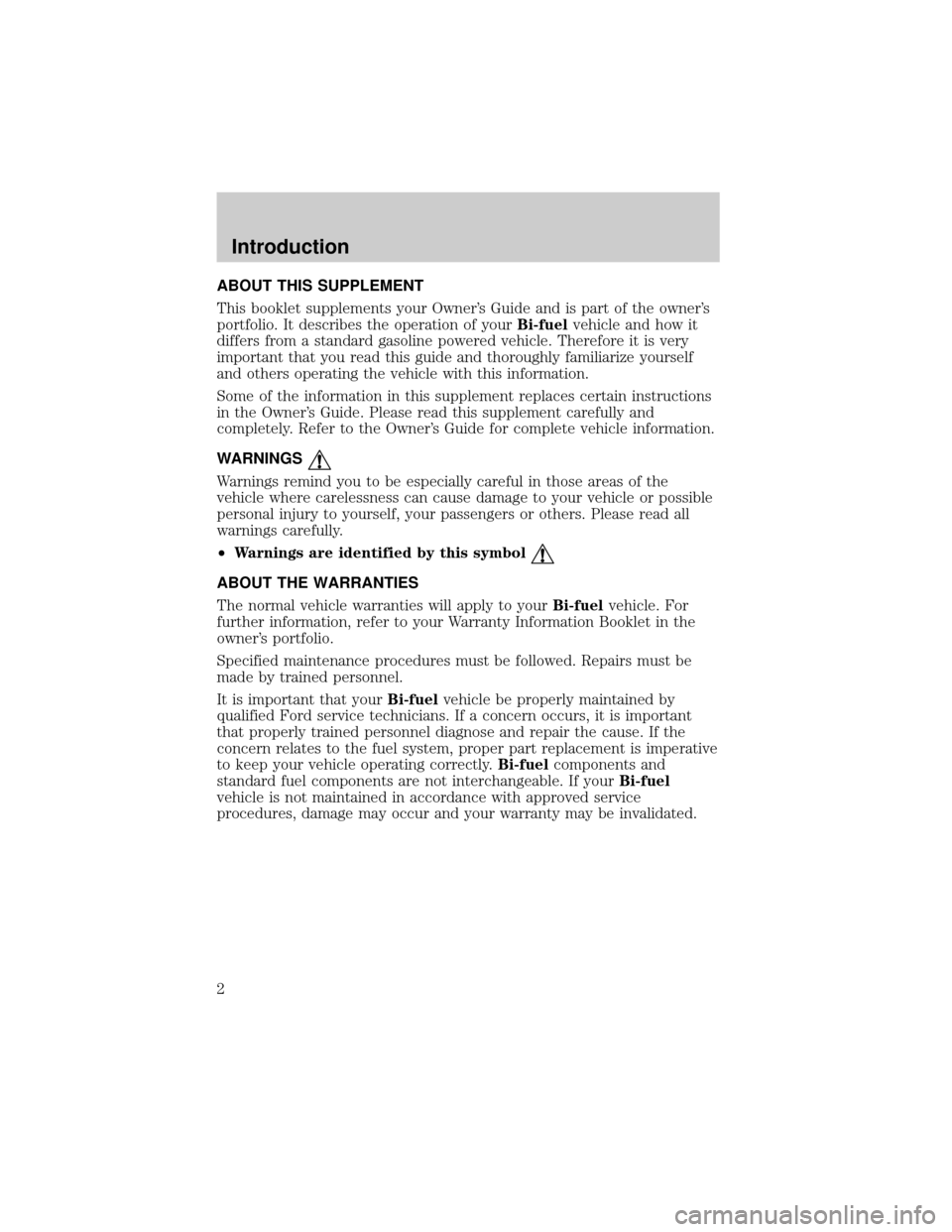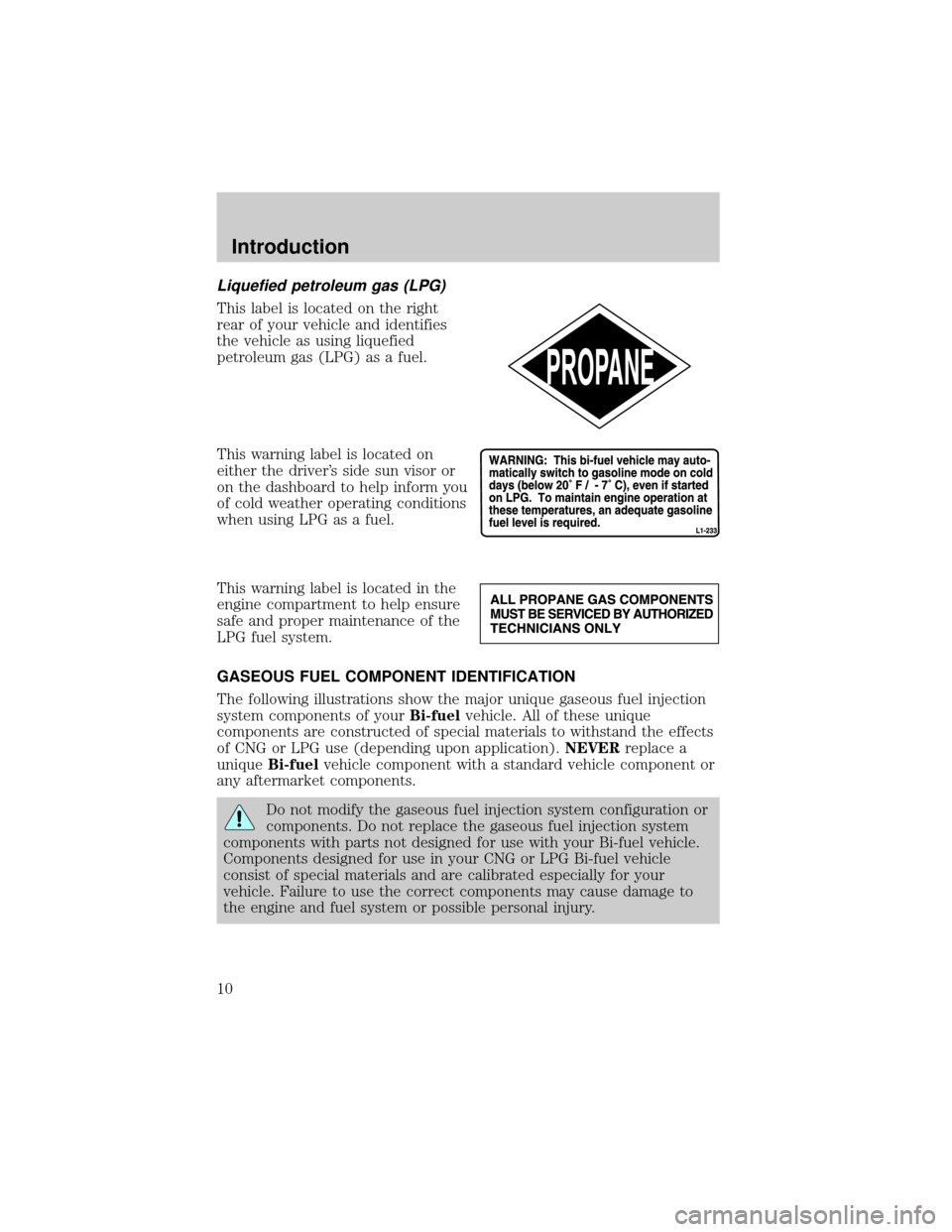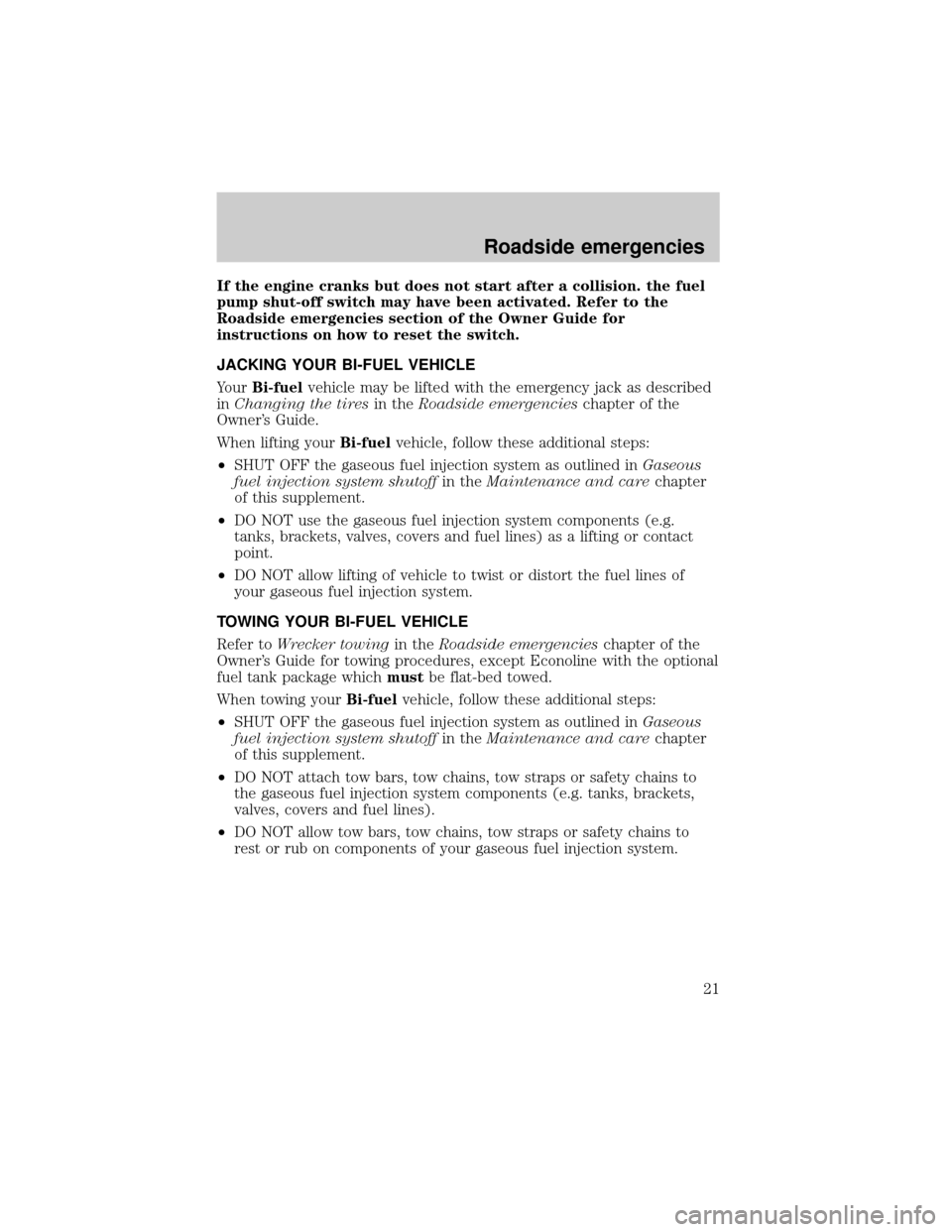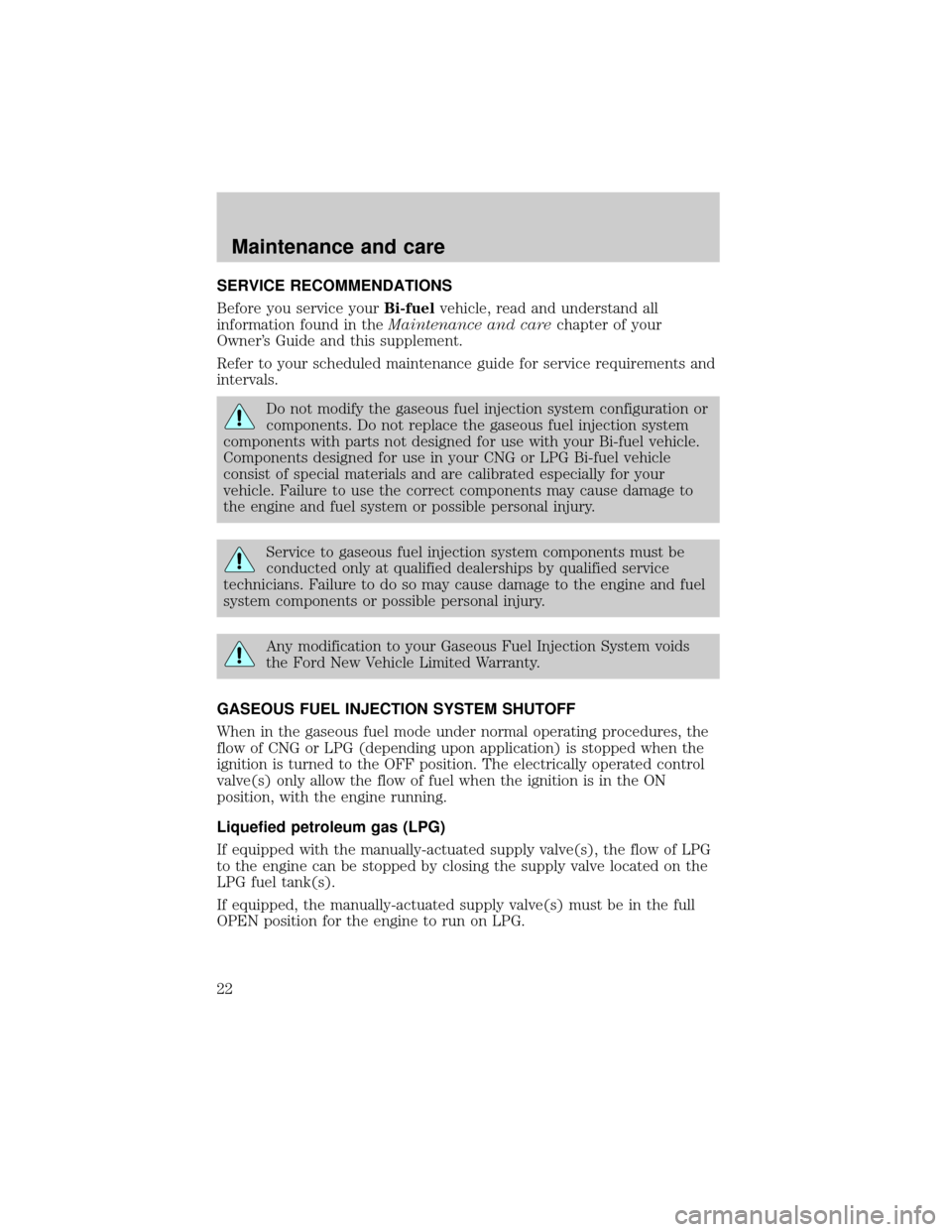Page 1 of 32
Introduction 2
Instrumentation and controls 13
Starting 16
Driving 18
Roadside emergencies 20
Maintenance and care 22
All rights reserved. Reproduction by any means, electronic or mechanical
including photocopying, recording or by any information storage and retrieval
system or translation in whole or part is not permitted without written
authorization from Ford Motor Company. Ford may change the contents without
notice and without incurring obligation.
Copyright 2001 Ford Motor Company
Table of contents
1
Page 2 of 32

ABOUT THIS SUPPLEMENT
This booklet supplements your Owner's Guide and is part of the owner's
portfolio. It describes the operation of yourBi-fuelvehicle and how it
differs from a standard gasoline powered vehicle. Therefore it is very
important that you read this guide and thoroughly familiarize yourself
and others operating the vehicle with this information.
Some of the information in this supplement replaces certain instructions
in the Owner's Guide. Please read this supplement carefully and
completely. Refer to the Owner's Guide for complete vehicle information.
WARNINGS
Warnings remind you to be especially careful in those areas of the
vehicle where carelessness can cause damage to your vehicle or possible
personal injury to yourself, your passengers or others. Please read all
warnings carefully.
²Warnings are identified by this symbol
ABOUT THE WARRANTIES
The normal vehicle warranties will apply to yourBi-fuelvehicle. For
further information, refer to your Warranty Information Booklet in the
owner's portfolio.
Specified maintenance procedures must be followed. Repairs must be
made by trained personnel.
It is important that yourBi-fuelvehicle be properly maintained by
qualified Ford service technicians. If a concern occurs, it is important
that properly trained personnel diagnose and repair the cause. If the
concern relates to the fuel system, proper part replacement is imperative
to keep your vehicle operating correctly.Bi-fuelcomponents and
standard fuel components are not interchangeable. If yourBi-fuel
vehicle is not maintained in accordance with approved service
procedures, damage may occur and your warranty may be invalidated.
Introduction
2
Page 9 of 32
Compressed natural gas (CNG)
This label is located on the right
rear of your vehicle and identifies
the vehicle as using compressed
natural gas (CNG) as a fuel.
This label (required only in
California) is located on the
dashboard and identifies your
vehicle as using CNG as a fuel.
This warning label is located in the
engine compartment to help ensure
safe and proper maintenance of the
CNG fuel system.
This label is located in the engine
compartment and on the CNG
tank(s) and lists the inspection and
expiration dates for the CNG fuel
tank(s).
Introduction
9
Page 10 of 32

Liquefied petroleum gas (LPG)
This label is located on the right
rear of your vehicle and identifies
the vehicle as using liquefied
petroleum gas (LPG) as a fuel.
This warning label is located on
either the driver's side sun visor or
on the dashboard to help inform you
of cold weather operating conditions
when using LPG as a fuel.
This warning label is located in the
engine compartment to help ensure
safe and proper maintenance of the
LPG fuel system.
GASEOUS FUEL COMPONENT IDENTIFICATION
The following illustrations show the major unique gaseous fuel injection
system components of yourBi-fuelvehicle. All of these unique
components are constructed of special materials to withstand the effects
of CNG or LPG use (depending upon application).NEVERreplace a
uniqueBi-fuelvehicle component with a standard vehicle component or
any aftermarket components.
Do not modify the gaseous fuel injection system configuration or
components. Do not replace the gaseous fuel injection system
components with parts not designed for use with your Bi-fuel vehicle.
Components designed for use in your CNG or LPG Bi-fuel vehicle
consist of special materials and are calibrated especially for your
vehicle. Failure to use the correct components may cause damage to
the engine and fuel system or possible personal injury.
Introduction
10
Page 14 of 32

When the selector switch is placed
in the GAS position, your engine will
operate in the unleaded gasoline
mode.
If the CNG or LPG (depending upon application) runs low during the
operation of the vehicle in the gaseous fuel mode, the gaseous fuel
injection system will automatically change to the unleaded gasoline
operating mode. The green indicator light on the fuel selector switch will
turn off to show the vehicle has changed to the unleaded gasoline
operating mode.
The vehicle's fuel system will NOT automatically change to the
gaseous fuel mode (CNG or LPG, depending upon application),
if the level of the unleaded gasoline runs low.
FUEL GAUGE
The fuel gauge in your CNG or LPGBi-fuelvehicle (depending upon
application) behaves similarly to a standard gasoline fuel gauge. The fuel
gauge will provide a linear reading from Full down to Empty.
²Fuel gauge operation for aLPG Bi-fuelvehicle is based on a float
type sensor measuring the level of the liquid propane in the fuel
tank(s).
²Fuel gauge operation for aCNG Bi-fuelvehicle is based on the
pressure and temperature of the natural gas in the fuel tank(s).
Depending upon the application, a full fuel gauge reading will occur at
a pressure of approximately 20 700 kPa (3 000 psi) or 24 800 kPa
(3 600 psi) at a temperature of approximately 21ÉC (70ÉF). For more
information on fuel gauge performance during the fast-fill method of
CNG fueling, refer toRefueling your Bi-fuel vehiclein the
Maintenance and carechapter of this supplement.
ALT
GAS
Instrumentation and controls
14
Page 21 of 32

If the engine cranks but does not start after a collision. the fuel
pump shut-off switch may have been activated. Refer to the
Roadside emergencies section of the Owner Guide for
instructions on how to reset the switch.
JACKING YOUR BI-FUEL VEHICLE
YourBi-fuelvehicle may be lifted with the emergency jack as described
inChanging the tiresin theRoadside emergencieschapter of the
Owner's Guide.
When lifting yourBi-fuelvehicle, follow these additional steps:
²SHUT OFF the gaseous fuel injection system as outlined inGaseous
fuel injection system shutoffin theMaintenance and carechapter
of this supplement.
²DO NOT use the gaseous fuel injection system components (e.g.
tanks, brackets, valves, covers and fuel lines) as a lifting or contact
point.
²DO NOT allow lifting of vehicle to twist or distort the fuel lines of
your gaseous fuel injection system.
TOWING YOUR BI-FUEL VEHICLE
Refer toWrecker towingin theRoadside emergencieschapter of the
Owner's Guide for towing procedures, except Econoline with the optional
fuel tank package whichmustbe flat-bed towed.
When towing yourBi-fuelvehicle, follow these additional steps:
²SHUT OFF the gaseous fuel injection system as outlined inGaseous
fuel injection system shutoffin theMaintenance and carechapter
of this supplement.
²DO NOT attach tow bars, tow chains, tow straps or safety chains to
the gaseous fuel injection system components (e.g. tanks, brackets,
valves, covers and fuel lines).
²DO NOT allow tow bars, tow chains, tow straps or safety chains to
rest or rub on components of your gaseous fuel injection system.
Roadside emergencies
21
Page 22 of 32

SERVICE RECOMMENDATIONS
Before you service yourBi-fuelvehicle, read and understand all
information found in theMaintenance and carechapter of your
Owner's Guide and this supplement.
Refer to your scheduled maintenance guide for service requirements and
intervals.
Do not modify the gaseous fuel injection system configuration or
components. Do not replace the gaseous fuel injection system
components with parts not designed for use with your Bi-fuel vehicle.
Components designed for use in your CNG or LPG Bi-fuel vehicle
consist of special materials and are calibrated especially for your
vehicle. Failure to use the correct components may cause damage to
the engine and fuel system or possible personal injury.
Service to gaseous fuel injection system components must be
conducted only at qualified dealerships by qualified service
technicians. Failure to do so may cause damage to the engine and fuel
system components or possible personal injury.
Any modification to your Gaseous Fuel Injection System voids
the Ford New Vehicle Limited Warranty.
GASEOUS FUEL INJECTION SYSTEM SHUTOFF
When in the gaseous fuel mode under normal operating procedures, the
flow of CNG or LPG (depending upon application) is stopped when the
ignition is turned to the OFF position. The electrically operated control
valve(s) only allow the flow of fuel when the ignition is in the ON
position, with the engine running.
Liquefied petroleum gas (LPG)
If equipped with the manually-actuated supply valve(s), the flow of LPG
to the engine can be stopped by closing the supply valve located on the
LPG fuel tank(s).
If equipped, the manually-actuated supply valve(s) must be in the full
OPEN position for the engine to run on LPG.
Maintenance and care
22
Page 23 of 32
Depending upon application, it may be necessary to remove an access
panel to close or open the supply valve(s).
1. Turn counterclockwise very slowly to the full OPEN position, if
equipped. Turning the supply valve quickly may activate the excess flow
valve. For more information, refer toCharging the fuel lines of your
LPG fuel systemin this chapter.
²F-150
2. Turn clockwise to the full CLOSED position, if equipped.
²F-150
FUEL QUALITY
Use of poor quality fuel may result in:
²component failure.
²leakage from the fueling point.
²poor vehicle operation.
Use of poor quality fuel may also result in your warranty being
invalidated.
Maintenance and care
23